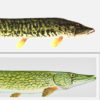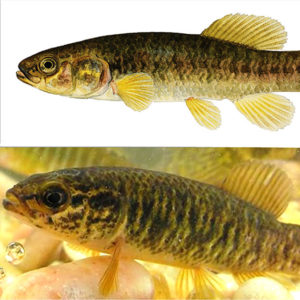calsfoundation@cals.org
Central Mudminnows
aka: Umbrids
The central mudminnow (Umbra limi) is a small (51 to 132 mm [2 to 5 in.]) fish that belongs to the Family Umbridae and Order Esociformes. There are three other North American members of the family: the eastern mudminnow (U. pygmaea) of the Eastern Seaboard and Atlantic Coastal Plain, the Alaska blackfish (Dallia pectoralis) that occurs in Alaska and adjacent Siberia, and the Olympic mudminnow (Novumbra hubbsi) of the Olympic Peninsula of Washington. All of these are strictly Northern Hemisphere freshwater species. A third Umbra species, the European Mudminnow (U. krameri), occurs widely throughout Europe. Mudminnows are most closely related to esocids (pikes and pickerels). The fossil record includes specimens that date back to the Oligocene of Eurasia and North America. The lone specimen found in Arkansas was collected in 1894.
The central mudminnow is widely distributed in central North America west of the Appalachian Mountains, including the St. Lawrence River, Great Lakes, Hudson Bay, Red River, and the Mississippi River basins from Quebec to Manitoba and south to central Ohio, western Tennessee, and perhaps (historically) northeastern Arkansas. This mudminnow is found in a variety of sluggish freshwater environments including moderately or densely vegetated bayous, ditches, lakes, ponds, streams, and wetlands near the littoral zone, or near the shore, and often around dense cover.
There is only a single historic record of U. limi in Arkansas. A lone specimen was collected in 1894 by the greatest single contributor to our knowledge of Arkansas fishes before 1900, Seth Eugene Meek (1859‒1914), from a bayou near Greenway (Clay County) of the St. Francis River drainage. It has not been collected in the nearly 125 years since it was last found in the state even though intensive searches have been made for U. limi in northeastern Arkansas. Several eminent ichthyologists have suggested U. limi is extirpated in Arkansas due to extensive channelization and agriculture (use of insecticides and pesticides) in the county and adjacent areas, which have greatly decreased its chances for persistence in the state. However, a single individual was collected from intake screens of a power plant on the Mississippi River near New Madrid (New Madrid County), in the bootheel of Missouri, which is about 81 km (50 mi.) upstream of the Arkansas border. In addition, there are several records of U. limi from northwestern Tennessee (Reelfoot Lake) and southwestern Kentucky.
The coloration of U. limi matches its habitat, being dark brownish above with a greenish tint, mottled sides, and a buff-colored pale belly. There is a conspicuous dark vertical bar at its caudal fin base. The lateral line is absent, and cycloid scales in the lateral series number thirty-four to thirty-seven. There are thirteen to fifteen dorsal fin rays and seven to nine anal fin rays. The single dorsal fin is situated in a posterior position and distinctly anterior to the anal fin origin.
This fish appears to prefer habitats with low dissolved oxygen levels, acidic pH, high turbidity, high water temperatures, low flow, and even sites subject to complete freezing. It is an especially hardy, physiologically tolerant fish of low oxygen levels and, as a result, U. limi is sometimes one of a very few or the only fish present in waters susceptible to winter or summer kills. The central mudminnow has been reported to burrow tail-first in mud, allowing it to live in watersheds unavailable to other fishes. It is able to adapt to periodic hypoxic conditions because it can rise to the surface to gulp air and absorb oxygen through its swim bladder.
The central mudminnow is an ambush carnivorous feeder in the benthic zone of freshwater habitats. It prefers a variety of prey, including amphipods, anisopterans, cladocerans, chironomids, coleopterans, copepods, gastropods, and ostracods. Adults are also known to feed in the winter on littoral fishes. Some predatory fishes that feed on the Umbra limi include the grass pickerel (Esox americanus), northern pike (E. lucius), sunfishes, and catfishes; it is also eaten by birds, foxes, and water snakes. Mudminnows are shoaling fishes that, rather than being by themselves, prefer to associate with other mudminnows. This behavioral mechanism appears to reduce their risk of predation. In some parts of its range, the central mudminnow is sold to anglers as bait fish.
Reproductively, U. limi generally spawns in mid-April in water temperatures of 13 to 16°C (55 to 60°F) with higher temperatures further stimulating spawning. Spawning usually takes place in shallow waters, and females are capable of producing 200 to 2,000 eggs per season that are scattered over vegetation; there is no parental care. The egg stage matures in about six days after which fry enter their larval stage of development. Their life span averages about two years, although some specimens have lived as long as seven to nine years.
A number of parasites have been reported from U. limi, especially larval trematodes.
For additional information:
Burr, Brooks M., and Melvin L. Warren Jr. Distributional Atlas of Kentucky Fishes. Scientific and Technical Series No. 4. Frankfort: Kentucky Nature Preserves Commission, 1986.
Carter, F. Allen. “Fishes Collected from the Mississippi River and Adjacent Flood Areas in Arkansas, River Mile 770.0 to River Mile 816.0.” MS thesis, Arkansas State University, Jonesboro, 1984.
Chilton, G., K. A. Martin, and J. H. Gee. “Winter Feeding: An Adaptive Strategy Broadening the Niche of the Central Mudminnow, Umbra limi.” Environmental Biology of Fishes 10 (1984): 215‒219.
Colgan, P., and B. Silburt. “Feeding Behavior of the Central Mudminnow, Umbra limi, in the Field and Laboratory.” Environmental Biology of Fishes 10 (1984): 209‒214.
Gilbert, Carter R. “Umbra limi (Kirkland), Central Mudminnow.” In Atlas of North American Freshwater Fishes, edited by D. S. Lee, et al. Raleigh: North Carolina State Museum of Natural History, 1980.
Helfman, Gene, Bruce B. Collette, Douglas E. Facey, and Brian W. Bowen. The Diversity of Fishes: Biology, Evolution, and Ecology. New York: John Wiley & Sons, 2009.
Hoffman, Glenn L. Parasites of North American Freshwater Fishes. 2nd ed. Berkeley: University of California Press, 2009.
Meek, S. E. “A List of Fishes and Mollusks Collected in Arkansas and Indian Territory in 1894.” Bulletin of the United States Fisheries Commission 15 (1895): 341‒349.
Paszkowski, C. A., and W. M. Tonn. “An Experimental Study of Factors Affecting the Distribution of Yellow Perch and Central Mudminnows Along a Species Richness Gradient.” Environmental Biology of Fishes 33 (1991): 399‒404.
Peckham, R. S., and C. F. Dineen. “Ecology of the Central Mudminnow, Umbra limi (Kirtland).” American Midland Naturalist 58 (1957): 222‒231.
Pflieger, William L. The Fishes of Missouri. Jefferson City: Missouri Department of Conservation, 1997.
Robinson, J. M., K. J. Jirka, and J. A. Chiotti. “Age and Growth Analysis of the Central Mudminnow, Umbra limi.” Applied Ichthyology 26 (2009): 89‒94.
Robison, Henry W., and Thomas M. Buchanan. Fishes of Arkansas. 2nd ed. Fayetteville: University of Arkansas Press, 2020.
Chris T. McAllister
Eastern Oklahoma State College
 Esocids
Esocids Science and Technology
Science and Technology Mudminnows
Mudminnows 




Comments
No comments on this entry yet.